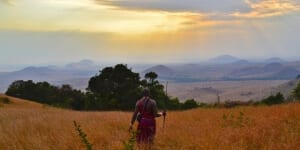Going on safari in Tanzania is relatively straightforward. The country has a well-developed tourist offering with easy and frequent access by plane, good internal flight options, a large variety of accommodation and English spoken as a second language by almost everyone. Bear in mind that if you’re planning to visit parks in the west of the country most roads are not tarmacked, making your safari weather dependent.
Tanzania’s geography is one of the most varied in Africa, and ranges from the Indian Ocean in the east to Africa’s highest point of Mount Kilimanjaro in the north, huge central plains and the great lakes to the east. All of this makes for multiple unique habitats, many of which are protected wildlife areas in the form of national parks and game reserves.
Tanzania is home to an estimated 4 million animals of over 430 species of classic African wildlife and over 1,000 species of birds. Wildlife of note in Tanzania includes large elephant and lion populations, as well as huge herds of grazers in the northern plains.
The two most popular routes for overland safaris in Tanzania are the “northern circuit” and the “southern circuit”, and both take in a selection of Tanzanian national parks. The northern circuit is the more popular of the two – with dense, accessible wildlife and more crowds and higher prices – and takes in Serengeti, Lake Manyara, Tarangire, Arusha and Kilimanjaro National Parks, and the Ngorongoro Conservation Area. The southern circuit covers Ruaha, Mikumi, Udzungwa Mountains National Parks and the Selous Game Reserve, with the same breadth of wildlife but spread over a larger, more wild landscape, and sees a smaller number of tourists.
Whilst self-drive safaris are an option in many national parks in Tanzania, this can be complicated by the need for an official guide. Given this fact, you’ll no doubt need to do a little research into the most suitable safari tour companies in Tanzania before arrival in the country.
| Timezone |
GMT +3
|
|---|---|
| Health Info | |
| Visa Requirements | |
| CIA Fact Book | |
| Currency |

Tanzania safari highlights
Watch the ‘Great Wildebeest Migration’
 Listed as one of the seven natural wonders of Africa, the awe-inspiring Great Wildebeest Migration sees more than two million wildebeest, zebra, and gazelle marching across the Masai Mara National Reserve in Kenya and the Serengeti and surrounding parks in Tanzania – closely followed by plenty of predators. Exact timings vary year to year, so be sure to check in with a local expert.
Listed as one of the seven natural wonders of Africa, the awe-inspiring Great Wildebeest Migration sees more than two million wildebeest, zebra, and gazelle marching across the Masai Mara National Reserve in Kenya and the Serengeti and surrounding parks in Tanzania – closely followed by plenty of predators. Exact timings vary year to year, so be sure to check in with a local expert.
Balloon safari over the Serengeti
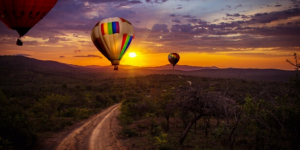
The Serengeti is one of the best balloon safari destinations in the world. As with any safari, game viewing can’t be guaranteed, but with an experienced captain and guide on hand to spot the game below, you’ll have a very good chance of seeing a variety of wildlife from a whole new perspective.
Big five spotting
Along with Kenya, Tanzania is home ot the classic African safari, with big five spotting near the top of every visitor’s wishlist. There are a number of world-class national parks in Tanzania to do just that, with both Lake Manyara and now the Serengeti hosting unique tree-climbing lions, for some extra wildlife wow-factor.
Dual-destination safari + beach

One of the beauties of taking a safari in Tanzania is easy access to the picture-postcard white sand beaches of Zanzibar. Many Tanzanian tour operators will help arrange your trip to work on your tan with a pre- or post-safari break on perfect Indian Ocean beach.
Best to safari in Tanzania
Tanzania has a year-round tropical climate, though there are some large regional variations. The coast is generally warmer and more humid than the interior, with the monsoon rains bringing two rain periods – the long rains from March to May and the short rains from November and December.
The best time to take a safari in Tanzania is from June to October when the rains have finished and the temperature is at its coolest. However, this is peak safari season with busy national parks and safari lodges in high demand. If you can put up with muddy – and occasionally impassable – roads, then the short rain season means decent discounts on safaris across Tanzania and usually decent wildlife viewing.
National parks in Tanzania
Tanzania is about as good as it gets when it comes to national parks for safaris. From desert-island national parks in Lake Victoria in the north, to mountainous chimp-filled forests around Lake Tanganika in the west, to the world-reknown Serengeti and Ngorogoro parks, are plenty of places to get your safari fix And if it’s the big 5 you’re after, they’re on offer in most national parks in Tanzania.
Top Tanzania national park picks
The Serengeti
The great migration – one of natures greatest shows – takes place each year in northern Tanzania with 1.5 million wildebeest and 1 million other grazers and predators travelling the Serengeti-Mara ecosystem.
Mahale National Park
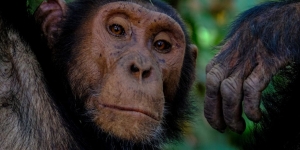
Get way out west at the Mahale National Park, a little visited park on the banks of Lake Tanganyika and home to several families of habituated chimpanzees.
Ngorongoro Conservation Area
Descending from the rim of the Ngorongoro crater to the wildlife packed crater floor below is a feeling like no other. Views stretch across the 8,290 km sq conservation area, created 3 million years ago, and home to a broad and dense selection of African species, most of which are unable to leave the crater. It’s one of the Seven Natural Wonders of Africa for a reason!
Selous National Park
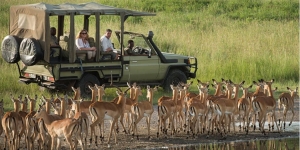
At 50,000 km sq Selous is the second largest conservation area in Africa, yet also one of the more remote safari options. The density and diversity of the wildlife here earned the park UNESCO world heritage status, and it’s famed for its huge concentration of elephants, estimated at up to 40,000. The best time to visit Selous is June to October, which is the high season, but still far less crowded that most other East African national parks.
Arusha National Park
Containing the often overlooked Mount Meru, with lakes and a large wildlife filled crater.
Gombe Stream National Park
52 km sq. of pristine forests creeping down to a huge lake.
Katavi National Park
Woodland area with a lake and floodplains.
Lake Manyara National Park
Forest surrounding the eponymous lake.
Mahala Mountains National Park
Lushly forested mountains descending to the shores of Lake Tanganika.
Mikumi Nationanal Park
Mkata floodplains.
Ngorogoro Crater National Park
8,300 km sq. of highlands and plains surrounding a giant extinct volcano crater.
Ruaha National Park
40,000 km sq. of national park with Ruaha river along with several sandy rivers.
Rubondo National Park
Covering 450 km sq. in total area, much of Rubondo is the waters of Lake Victoria with one dense forest-covered island and a number of small islets.
Saadani National Park
1,000 km sq. Costal wilderness with deserted beaches.
Selous National Park
45,000 km sq. Rufiji river and lakes surrounding woodland.
Serengeti National Park
14,763 km sq. Hilly scrub lands with endless plains.
Tarangire National Park
Boabab studded woodland aorund the Tarangire river.
Other Tanzania safari resources
Tanzania safari companies
There’s no shortage of companies offering safari tours in Tanzania, and whilst self-drive safaris are an option you will need a local guide with you, so you’ll probably need to work with a tour company in some capacity. Budgets of all sizes are catered for – from entry-level guide-only day trips to itineraries taking in some of Africa’s finest national parks staying in luxury camps. Check out our reviews of safari tour companies in Tanzania.
Tanzania safari lodges
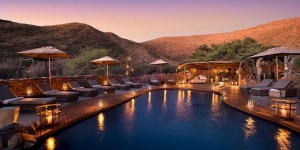
Tanzania has a wide choice of safari accommodation – from budget camping opportunities to luxury tented accommodation. As rule prices at safari lodges in Tanzania tend to be on a full board basis, and also include game drives and park fees. Be sure to check with the accommodation before booking exactly what’s included. Beach accommodation in Tanzania is generally bed and breakfast. Search and book accommodation in Tanzania, or use the map below.



